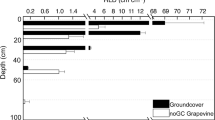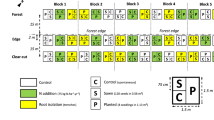Abstract
Detrimental effects of vines on tree growth in successional environments have been frequently reported. Little is known, however, about the relative importance of below and aboveground competition from vines on tree growth. The objective of this study was to quantify and compare the growth responses of Liquidambar styraciflua saplings to below and/or aboveground competition with the exotic evergreen vine, Lonicera japonica (Japanese honeysuckle), and the native deciduous vine, Parthenocissus quinquefolia (Virginia creeper). Soil trenching and/or vine-trellising were used to control the type of vine competition experienced by trees. Comparisons among untrenched treatments tested for effects of belowground competition. Comparisons among trenched treatments tested for effects of aboveground competition. After two growing seasons, Lonicera japonica had a greater effect on the growth of L. styraciflua than did P. quinquefolia. This effect was largely due to root competition, as canopy competition only had a negative effect on tree growth when it occurred in combination with root competition. Leaf expansion was consistently and similarly affected by all treatments which involved belowground competition.
Similar content being viewed by others
References
Aspinall D (1960) An analysis of competition between barley and white persicaria. Ann Appl Biol 48: 637–654
Baker FS (1950) Principles of silviculture. McGraw Hill, New York
Bell DJ, Forseth IN, Teramura AH (1988) Field water relations of three temperate vines. Oecologia 74: 537–545
Boring LR, Monk CD, Swank WT (1981) Early regeneration of a clear-cut southern Appalachian forest. Ecology 62: 1244–1253
Bormann FH (1953) Factors determining the role of loblolly pine and sweetgum in early old-field succession in the piedmont of North Carolina. Ecol Monogr 23: 339–358
Boyer JS (1988) Cell enlargement and growth-induced water potentials. Physiol Plant 73: 311–316
Brown RG, Brown ML (1972) Woody plants of Maryland. Port City Press, Baltimore
Bruner MH (1967) Honeysuckle—a bold competitor on bottomland hardwood sites. For Farmer 26: 9–17
Caldwell MM (1986) Root system competition in natural communities. In: Gregory PJ (ed) Root development and function, effects of the physical environment. Cambridge University Press, Cambridge, pp 162–185
Chapin FS III (1991) Integrated responses of plants to stress. Bioscience 41: 29–36
Clements FE, Weaver JE, Hanson HC (1929) Plant competition: an analysis of community functions. Carnegie Institute. Washington
Cogliastro A, Gagnon D, Coderre D, Bhereur P (1990) Response of seven hardwood tree species to herbicide, rototilling, and legume cover at two southern Quebec plantation sites. Can J For Res 20: 1172–1182
Donald CM (1958) The interaction of competition for light and for nutrients. Aust J Agric Res 9: 421–35
Featherly HI (1941) The effect of grapevines on trees. Proc Oklahoma Acad Sci 21: 61–62
Friedland AJ, Smith AP (1982) Effects of vines on successional herbs. Am Midl Nat 108: 402–403
Holbrook NM, Putz F (1989) Influence of neighbors on tree form: effects of lateral shade and prevention of sway on the allometry of Liquidambar styraciflua (sweet gum). Am J Bot 76: 1704–1749
Horn HS (1971) The adaptive geometry of trees. Princeton University Press, Princeton
Horn JC (1985) Responses of understory tree seedlings to trenching. Am Midl Nat 114: 252–258
Jackson LWR (1967) Effect of shade on leaf structure of deciduous tree species. Ecology 48: 498–499
Jones RH, Sharitz RR (1990) Effects of root competition and flooding on growth of chinese tallow seedlings. Can J For Res 20: 573–578
Jones RH, Sharitz RR, McLeod MKW (1989) Effects of flooding and root competition on growth of shaded bottomland hardwood seedlings. Am Midl Nat 121: 165–175
Kennedy HE Jr (1981) Foliar nutrient concentrations and hardwood growth influenced by cultural treatments. Plant Soil 63: 307–316
King J (1971) Competition between established and newly sown grass species J Br Grassld Soc 26: 221–229
Kolb TE, Steiner KC (1990) Growth and biomass partitioning of northern red-oak and yellow poplar seedlings: effects of shading and grass root competition. For Sci 36: 34–44
Leatherman AD (1955) Ecological life history of Lonicera japonica Thunb. Ph D Dissertation, University of Tennessee, Knoxville
Little S (1961) Recent results of tests in controlling Japanese honeysuckle. Hormolog 3: 8–10
Lutz HJ (1943) Injuries to trees caused by Celastrus and Vitis. Bull Torrey Bot Club 70: 436–439
Martin MPLD, Snaydon RW (1982) Root and shoot interactions between barley and field beans when intercropped. J Appl Ecol 19: 263–272
Monsi M, Murata Y (1970) Development of photosynthetic systems as influenced by distribution in matter. In: Prediction and measurements of photosynthetic productivity. PUDOC, Wageningen, pp 115–130
Patterson DT (1973) The ecology of oriental bittersweet, Celastrus orbiculatus, a weedy introduced ornamental vine. Ph D Dissertation, Duke University, Durham, NC
Penfound WT (1974) The role of vines in plant communities. Adv Frontiers Plant Sci 17: 187–192
Putz FE (1984) The natural history of lianas on Barro Colorado Island, Panama. Ecology 68: 1713–1724
Radin JW, Boyer JS (1982) Control of leaf expansion by nitrogen nutrition in sunflower plants. Role of hydraulic conductivity and turgor. Plant Physiol 69: 771–775
Richards PW (1952) The tropical rain forest; an ecological study. Cambridge University Press, London
Roden J, Van Volkenburgh E, Hinckley TM (1990) Cellular basis for limitation of poplar leaf growth by water deficit. Tree Physiol 6: 211–219
Siccama TG, Weir G, Wallace K (1976) Ice damage in a mixed hardwood forest in Connecticut in relation to Vitis infestation. Bull Torrey Bot Club 103: 180–183
Slezak WF (1976) Lonicera japonica Thumb., an aggressive introduced species in a mature forest ecosystem. MS Thesis, Rutgers University, New Brunswick, NJ
Steinberg SL, Miller JC Jr, McFarland MJ (1990) Dry matter partitioning and vegetative growth of young peach trees under water stress. Aust J Plant Physiol 17: 23–36
Stevens GC (1987) Lianas as structural parasites: the Bursera simaruba example. Ecology 68: 77–81
Teramura AH, Forseth IN, Gold W (1991) Physiological ecology of mesic, temperate vines. In: Mooney H, Putz FE (eds) Biology of Vines. Cambridge University Press, Cambridge, pp 237–277
Thomas LK Jr (1980) The impact of three exotic plant species on a Potomac island. National Park Service Scientific Monograph Service, No. 13. US Dept of Interior, Washington, DC
Whigham D (1984) The influence of vines on the growth of Liquidambar styraciflua L. (sweetgum). Can J For Res 14: 37–39
Wilson JB (1988) Shoot competition and root competition. J Appl Ecol 25: 279–296
Wilson JB (1989) Root competition between three upland grasses. Funct Ecol 3: 447–451
Wullschleger SD, Oosterhuis DM (1990) Canopy development and photosynthesis of cotton as influenced by nitrogen nutrition. J Plant Nutr 13: 1141–1154
Zimmermann MH, Brown CL (1977) Trees, structure and function. Springer, New York
Author information
Authors and Affiliations
Rights and permissions
About this article
Cite this article
Dillenburg, L.R., Whigham, D.F., Teramura, A.H. et al. Effects of below- and aboveground competition from the vines Lonicera japonica and Parthenocissus quinquefolia on the growth of the tree host Liquidambar styraciflua . Oecologia 93, 48–54 (1993). https://doi.org/10.1007/BF00321190
Received:
Accepted:
Issue Date:
DOI: https://doi.org/10.1007/BF00321190




